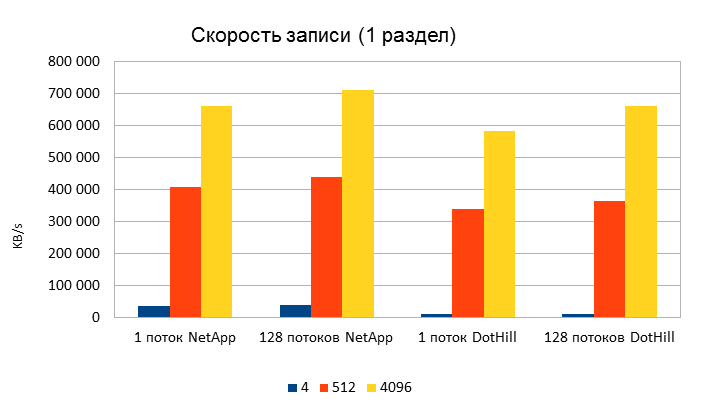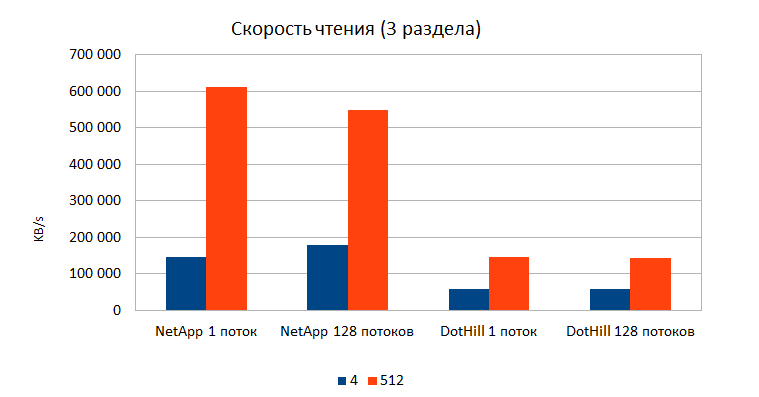Comparison of DotHill and NetApp Disk Array Performance

In this post we will compare the DotHill 3730 and NetApp 5412 disk arrays. Comparison and testing were carried out to determine the feasibility of changing DotHill storage systems to NetApp cd.
One of the IT-GRAD customers has used the DotHill 3730 disk arrays for many years to store everything they need, but it's time to change them. It’s not that they were bad, they simply accumulated “grievances” over several years of operation, the requirements changed and a new one was wanted.
The requirements for the storage system under test are as follows:
- 20TB of user space;
- storage reliability;
- read and write speed with a block size of 512 bytes of at least 200 megabytes per second.
NetApp storage systems perfectly meet the above requirements, but testing was organized to make it more convincing.
To test the disk array, we put together a stand:
- server (SuperMicro 6027R-TRF / E5-2670 - 2 pcs. / 64 GB RAM / QLogic ISP2532 - 2 pcs.) - 1 pc.
- NetAPP E5412 RAID Array - 1 pc.
- DotHill 3730 RAID Array - 1 pc.
The NetAPP disk array (NetAPP) was tested first, it used one of the two controllers, connected to the server through four FC ports. The DotHill (DotHill) disk array has 2 ports on each controller, they used everything to balance the theoretical throughput. Each of the disk arrays was tested separately from the other, connected directly to the server. On each of the disk arrays, the disks were combined into one LUN (RAID-6) and left 1 disk in the hot reserve, the LUN was divided into 4 equal parts.
To obtain the characteristics of disk arrays, the “Flexible I / O tester” (fio) test package was used, which performs operations on the specified file, device, or several files or devices at once. Working directly with the device, in our case with four partitions stored on a disk array, allows you to exclude the file system from consideration, as well as reduce the effect on all kinds of caches on the received characteristics. The following modes are available for testing:
- reading;
- record;
- random reading;
- random record;
- simultaneous reading and writing;
- simultaneous random reading and random writing.
For each of the modes, you can set your own data block size and the number of simultaneous streams. We were mainly interested in the speed of reading and writing, and the number of operations per second (IOPs) and other parameters were also recorded. The ability to test several devices at the same time, indicating for each their own settings, was very useful for simulating a real load.
During the creation of the stand, DotHill was configured through the built-in WEB-interface. In the same interface, you can get information about its status. There is not much information, but there is a necessary minimum.
NetApp has no WEB interface. To configure it, the installation of additional software SANTrisity 10.83 was required. The interface turned out to be intuitive, the configuration of the problems did not cause, and access to the characteristics and state of the hardware turned out to be simply gorgeous. For the sake of interest, we compared the test results and data on the speeds and IOPs that the software issued in real time. With decent accuracy, the data matched.
We decided to start by checking how all ports and partitions are the same, whether the controller has a pet. Having tormented both disk arrays for a couple of days, no significant difference was found, the spread of characteristics did not exceed 1% of the average value for the test.
Then we decided to check what one section of four is capable of, launching a test suite in all available modes, with data block sizes of 4, 16, 32, 128, 512, 1024, 2048 and 4096 kilobytes. With the number of streams 1, 16, 128 and 1024 for each size of data blocks, it lasted a little more than a week. Of course, with the preservation of all protocols.
Having properly driven only one section, we took up three at once. Three sections were not chosen by chance, in this mode the disk array as a part of a computer complex is simulated, and the fourth section should store “golden copies”. The test suite did not change much, they refused only to simulate streaming recording (block sizes 1024, 2048 and 4096 were excluded).
In order not to frighten the public with the huge stream of numbers that we have collected, here we present only graphs with the main characteristics.




An analysis of the data revealed a very interesting point.
During the test of 3 partitions in combined read and write mode with a data block size of 4 kilobytes, the difference in performance was eighteen times in favor of NetAPP, both for reading and writing. Apparently, this difference arose due to advanced NetAPP brains that are well optimized for working in this mode.In other modes, the E5412 also bypasses DotHill. Averaging all the data obtained on tests of three sections, it turned out that NetApp is about 4 times faster than DotHill.
In terms of administration capabilities, SANTricity provides all the necessary tools for the administrator. The administration interface from DotHill is inferior to SANTricity in features, especially in terms of collecting performance statistics.
As for the price
The "corporate" price of NetAPP E-5412 at the time of testing is only 1.6 times higher than the price of the similar DotHill 3730. If the price of NetApp was approximately 3,600,000 rubles, then Dothill cost approximately 2,250,000 rubles. Since the time of testing, and this is about six months ago, the new NetApp E-2700 model for people with modest requests has been released. Its recommended cost is more than 1.12 times that of DotHill 3730. Built E-2700 on the same principles as the model E-5400, but has a lower controller bandwidth.
We also measured the power consumption during the tests. We got NetApp - 280W, DotHill - 227W.
So, the conclusion is obvious: the change of DotHill equipment to NetApp is fully justified. In terms of price-quality ratioNetApp is the best in class solution.
